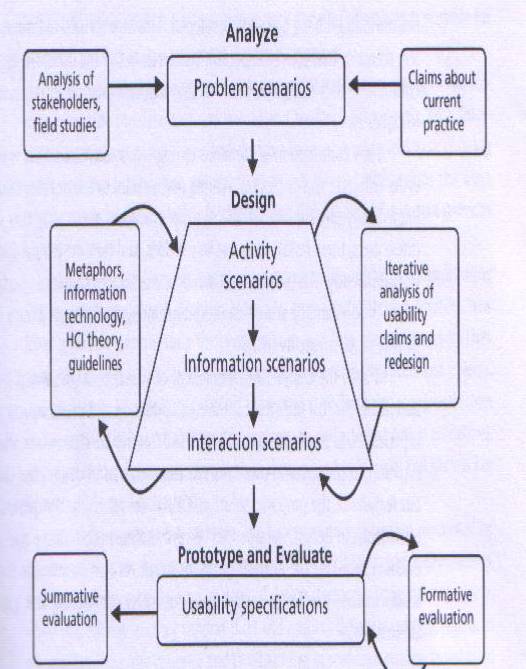Scenario-based usability engineering: Difference between revisions
Jump to navigation
Jump to search
m (→Definition) |
mNo edit summary |
||
| Line 1: | Line 1: | ||
{{Stub}} | {{Stub}} | ||
== Definition == | == Definition == | ||
Revision as of 14:51, 24 April 2007
Definition
Scenario-based Usability Engineering (SUNA) is a design methodology
Scenario-based design elaborates a traditional theme in human factors and ergonomics, namely, the principle that human charac- teristics and needs should be pivotal considerations in the design of tools and artifacts. In scenario-based design, descriptions of usage situations become more than just orienting examples and background data, they become first-class design objects. Scenario-based design takes literally the adage that a tool is what people can do with it - the consequences it has for them and for their activities that use it (Beth and Carroll, 2002).
References
- Fowler, C.J.H, van Helvert, J; Gardner, M.G, and Scott, J.R. (in press). The use of scenarios in designing and delivering learning systems. In H. Beetham & R. Sharpe, Rethinking Pedagogy in a Digital Age: Designing and delivering e-learning. London: Routledge.
- Carroll, J.M (1995) Introduction: The Scenario Perspective on System Development. In J.M. Carroll (ed.) Scenario-Based Design: Envisioning work and Technology in System Development New York: Wiley
- Hutt, A.T.H., Donnelly, N., Macaulay, L.A., Fowler, C.J.H., & Twigger, D. (1988) Describing a product opportunity : A method for understanding the users' environment. In D. Diaper & R. Winder (eds). People & Computers III. Cambridge: CUP.
- Rosson, M.B. and Carroll, J.M. (2002) Usability Engineering: Scenario-based Development of Human-Computer Interaction. London: Academic Press.
- Rosson, Mary Beth and John M. Carroll (2002), Scenario-based usability engineering, Proceedings of the conference on Designing interactive systems: processes, practices, methods, and techniques. http://doi.acm.org/10.1145/778712.778776 (PDF)
- Rosson, M. B., Carrol, J. M., and Rodi, C. 2004a. Case studies for teaching usability engineering. In Proceedings of the 35th SIGCSE Technical Symposium on Computer Science Education (Norfolk, VA, March 3-7, 2004). ACM Press, New York, 36-40.
- Rosson, M. B., Carrol, J. M., and Rodi, C. 2004b. Teaching computer scientists to make use. In Putting Scenarios Into Practice: The State of the Art in Scenarios and Use Cases. I. F. Alexander and N. Maiden (eds.). John Wiley, New York.
- Carroll, John M. and Mary Beth Rosson, A Case Library for Teaching Usability Engineering: Design Rationale, Development, and Classroom Experience, ACM Journal on Educational Resources in Computing, Vol. 5, No. 1, March 2005. PDF
- Van Helvert, J. and Fowler, C. (2004) 'Scenarios for Innovation (SUNA)', in Alexander and N. Maiden (eds.) Scenarios and Use Cases Stories through the System Life-Cycle. London: Wiley.
